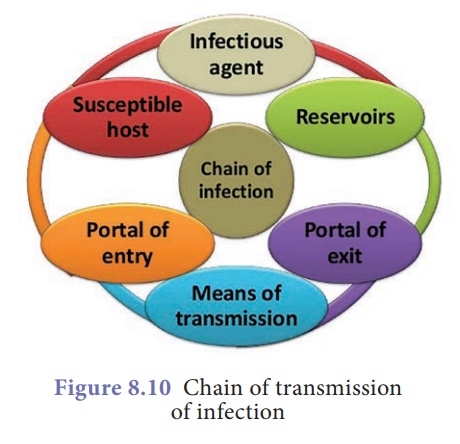Chapter: 9th Science : World of Microbes
Microbes and Diseases
Microbes and Diseases
Disease (dis = against;
ease = comfort) can be defined as an impairment or malfunctioning of the normal
state of the living organism that disturbs or modifies the performance of vital
functions of the body. Disease can be categorized based on:
i. The extent of occurrence (endemic, epidemic, pandemic or
sporadic).
ii. Whether infectious
or non-infectious.
iii. Types of pathogen
– whether caused by bacterial, viral, fungal or protozoan infections.
iv. Transmitting agent – whether air borne, water borne or vector borne.
1. Classification of disease based on occurence
Endemic: When the disease is
found in a certain geographical area affecting a fewer number of people
(low incidence). e.g. Occurrence of goitre in Sub-Himalayan regions.
Epidemic : When the disease breaks
out and affects large number of people in a particular geographical
region and spreads at the same time. e.g. Influenza.
Pandemic: When the disease is
widely distributed on a global scale. e.g. Acquired Immunodeficiency
Syndrome (AIDS).
Sporadic: When there is an
occasional occurrence of a disease. e.g. Malaria and Cholera.
2. Manifestation of Disease
Communicability of diseases
Infectious diseases are
communicable diseases. They are caused by external factors like pathogenic
organisms (bacteria, virus, vectors, parasites) invading the body and causing
diseases. e.g. Influenza, Tuberculosis, Chickenpox, Cholera, Pneumonia,
Malaria, etc
Non-infectious disease
are non-communicable diseases. They are caused by internal factors like
malfunctioning of organs, genetic causes, hormonal imbalance and immune system
defect. e.g. Diabetes, Coronary heart diseases, Obesity, Cancer, Goitre, etc
Point of entry and place of infection
The disease causing
microbes enter the body through different means. An infection develops when
these pathogens enter the human body through contaminated air, water, food,
soil, physical contact, sexual contact and through infected animals. They may
be organ specific or tissue specific within our body where microbes reside.
Reservoir of infection
Reservoir of infection
refers to the specific environment in which the pathogens can thrive well and
multiply without causing diseases. In other words, they are the breeding ground
for pathogens. eg. Water, soil and animal population.
Incubation period
The interval between
infection and first appearance of the diseases is called incubation period. It
may vary from few hours to several days.

Infection and Illness
Infection is the entry,
development or multiplication of an infectious agent in the human body or
animals. An illness is due to a specific infectious agent, capable of being
directly or indirectly transmitted from person to person, animal to animal or
from the environment (through air, water and food) and insects (vectors).
3. Harmful effects of microbes
Pathogens cause disease
in two ways. They are tissue damage and toxin secretion.
Tissue Damage: Many pathogens destroy
the tissues or organs of the body causing morphological and functional damage.
For example, bacterium of pulmonary tuberculosis damages the cells of the
lungs, and virus causing hepatitis destroys liver tissue.
Toxin Secretion: Many pathogens secrete
poisonous substances called toxins which cause diseases. Exotoxins
are directly secreted by the pathogens. Endotoxins are released by the
disintegration of pathogens.
Let us now study the
causative organism, mode of infection, occurrence, symptoms and preventive
measures of a few airborne, waterborne, vectorborne and sexually transmitted
diseases.
Related Topics